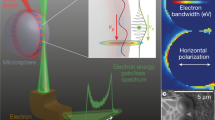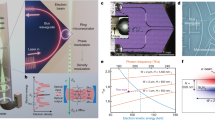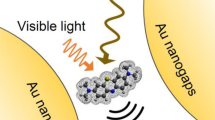Abstract
Optical microresonators have proven powerful in a wide range of applications1, including cavity quantum electrodynamics2,3,4, biosensing5, microfludics6, cavity optomechanics7,8,9 and optical frequency combs10. Their performance depends critically on the exact distribution of optical energy, confined and shaped by the nanoscale device geometry. Near-field optical probes11 can image this distribution, but the physical probe necessarily perturbs the near field, which is particularly problematic for sensitive high-quality-factor resonances12,13. We present a new approach to mapping nanophotonic modes that uses a controllably small and local optomechanical perturbation introduced by a focused lithium ion beam14. An ion beam (radius of ≈50 nm) induces a picometre-scale deformation of the resonator surface, which we detect through shifts in the optical resonance wavelengths. We map five modes of a silicon microdisk resonator (Q ≥ 20,000) with high spatial and spectral resolution. Our technique also enables in situ observation of ion implantation damage and relaxation dynamics in a silicon lattice15,16.
This is a preview of subscription content, access via your institution
Access options
Subscribe to this journal
Receive 12 print issues and online access
$209.00 per year
only $17.42 per issue
Buy this article
- Purchase on Springer Link
- Instant access to full article PDF
Prices may be subject to local taxes which are calculated during checkout



Similar content being viewed by others
References
Ilchenko, V. S. & Matsko, A. B. Optical resonators with whispering-gallery modes—Part II: applications. IEEE J. Sel. Top. Quantum Electron. 12, 15–32 (2006).
Raimond, J., Brune, M. & Haroche, S. Manipulating quantum entanglement with atoms and photons in a cavity. Rev. Mod. Phys. 73, 565–582 (2001).
Mabuchi, H. & Doherty, A. C. Cavity quantum electrodynamics: coherence in context. Science 298, 1372–1377 (2002).
Srinivasan, K. & Painter, O. Linear and nonlinear optical spectroscopy of a strongly coupled microdisk–quantum dot system. Nature 450, 862–865 (2007).
Vollmer, F. & Arnold, S. Whispering-gallery-mode biosensing: label-free detection down to single molecules. Nature Methods 5, 591–596 (2008).
Monat, C., Domachuk, P. & Eggleton, B. J. Integrated optofluidics: a new river of light. Nature Photon. 1, 106–114 (2007).
Kippenberg, T. J. & Vahala, K. J. Cavity optomechanics: back-action at the mesoscale. Science 321, 1172–1176 (2008).
Srinivasan, K., Miao, H., Rakher, M. T., Davanço, M. & Aksyuk, V. Optomechanical transduction of an integrated silicon cantilever probe using a microdisk resonator. Nano Lett. 11, 791–797 (2011).
Eichenfield, M., Camacho, R., Chan, J., Vahala, K. J. & Painter, O. A picogram- and nanometre-scale photonic-crystal optomechanical cavity. Nature 459, 550–555 (2009).
Kippenberg, T. J., Holzwarth, R. & Diddams, S. A. Microresonator-based optical frequency combs. Science 332, 555–559 (2011).
Rotenberg, N. & Kuipers, L. Mapping nanoscale light fields. Nature Photon. 8, 919–926 (2014).
Götzinger, S., Demmerer, S., Benson, O. & Sandoghdar, V. Mapping and manipulating whispering gallery modes of a microsphere resonator with a near-field probe. J. Microsc. 202, 117–121 (2001).
Mujumdar, S. et al. Near-field imaging and frequency tuning of a high-Q photonic crystal membrane microcavity. Opt. Express 15, 17214–17220 (2007).
Twedt, K. A., Chen, L. & McClelland, J. J. Scanning ion microscopy with low energy lithium ions. Ultramicroscopy 142, 24–31 (2014).
Morehead, F. F. & Crowder, B. L. A model for the formation of amorphous Si by ion bombardment. Radiat. Eff. 6, 27–32 (1970).
Myers, M., Charnvanichborikarn, S., Shao, L. & Kucheyev, S. Pulsed ion beam measurement of the time constant of dynamic annealing in Si. Phys. Rev. Lett. 109, 095502 (2012).
Thompson, J. D. et al. Coupling a single trapped atom to a nanoscale optical cavity. Science 340, 1202–1205 (2013).
Knight, J. C. et al. Mapping whispering-gallery modes in microspheres with a near-field probe. Opt. Lett. 20, 1515 (1995).
Sapienza, R. et al. Deep-subwavelength imaging of the modal dispersion of light. Nature Mater. 11, 781–787 (2012).
Coenen, T., van de Groep, J. & Polman, A. Resonant modes of single silicon nanocavities excited by electron irradiation. ACS Nano 7, 1689–1698 (2013).
Nelayah, J. et al. Mapping surface plasmons on a single metallic nanoparticle. Nature Phys. 3, 348–353 (2007).
García de Abajo, F. J. Optical excitations in electron microscopy. Rev. Mod. Phys. 82, 209–275 (2010).
Garcia de Abajo, F. J. & Kociak, M. Electron energy-gain spectroscopy. New J. Phys. 10, 073035 (2008).
Le Thomas, N. et al. Imaging of high-Q cavity optical modes by electron energy-loss microscopy. Phys. Rev. B 87, 155314 (2013).
Barwick, B., Flannigan, D. J. & Zewail, A. H. Photon-induced near-field electron microscopy. Nature 462, 902–906 (2009).
Yurtsever, A., van der Veen, R. M. & Zewail, A. H. Subparticle ultrafast spectrum imaging in 4D electron microscopy. Science 335, 59–64 (2012).
Johnson, S. G. et al. Perturbation theory for Maxwell's equations with shifting material boundaries. Phys. Rev. E 65, 066611 (2002).
Peng, B. et al. Loss-induced suppression and revival of lasing. Science 346, 328–332 (2014).
Hennessy, K., Högerle, C., Hu, E., Badolato, A. & Imamoğlu, A. Tuning photonic nanocavities by atomic force microscope nano-oxidation. Appl. Phys. Lett. 89, 041118 (2006).
Béland, L. K. & Mousseau, N. Long-time relaxation of ion-bombarded silicon studied with the kinetic activation–relaxation technique: microscopic description of slow aging in a disordered system. Phys. Rev. B 88, 214201 (2013).
Goldberg, R. D., Williams, J. S. & Elliman, R. G. Amorphization of silicon by elevated temperature ion irradiation. Nucl. Instrum. Methods B 106, 242–247 (1995).
Knuffman, B., Steele, A. V., Orloff, J. & McClelland, J. J. Nanoscale focused ion beam from laser-cooled lithium atoms. New J. Phys. 13, 103035 (2011).
Ziegler, J., Biersack, J. & Ziegler, M. SRIM—The Stopping and Range of Ions in Matter (SRIM Co., 2008); www.srim.org.
Acknowledgements
The authors thank N. Zhitenev for proposing the initial experiments that led to this work, and K. Dill for assistance preparing the image in Fig 1b. K.A.T. and J.Z. acknowledge support under the Cooperative Research Agreement between the University of Maryland and the National Institute of Standards and Technology Center for Nanoscale Science and Technology, award no. 70NANB10H193, through the University of Maryland.
Author information
Authors and Affiliations
Contributions
K.A.T., J.Z., J.J.M. and V.A.A. designed the experiments. J.Z. and V.A.A. fabricated and characterized the microdisk. K.A.T. and J.J.M. operated the lithium ion beam instrument. K.A.T. and J.Z. analysed the data and wrote the draft manuscript. M.D. and K.S. performed the optical modelling and mode perturbation calculations. All authors contributed to interpreting the data and editing the manuscript.
Corresponding author
Ethics declarations
Competing interests
The authors declare no competing financial interests.
Supplementary information
Supplementary information
Supplementary information (PDF 939 kb)
Rights and permissions
About this article
Cite this article
Twedt, K., Zou, J., Davanco, M. et al. Imaging nanophotonic modes of microresonators using a focused ion beam. Nature Photon 10, 35–39 (2016). https://doi.org/10.1038/nphoton.2015.248
Received:
Accepted:
Published:
Issue Date:
DOI: https://doi.org/10.1038/nphoton.2015.248



